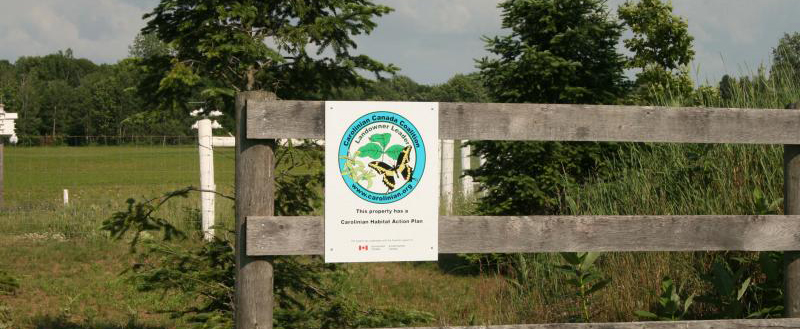
Landowner Leaders Profile
In 2005, Kathryn and her husband Michael moved to their 51 acre farm on the west edge of Norfolk County. The property had 35 acres of arable farmland planted to corn and soybeans, and another 13.5 acres of woodlot with a stream and steep ravine. They named their new home “Fairnorth Farm”.
Initially, the Boothbys talked to neighbours, began monitoring their property to familiarize themselves with the local flora and fauna, and noted the presence of invasives and species at risk. Kathryn joined several conservation group boards, including the Otter Valley Naturalists and the Long Point Basin Land Trust, which allowed her to learn more about the natural heritage of Norfolk County. They also completed an Environmental Farm Plan and continued to lease their arable land to an adjacent farmer.
Their first project involved removing 3 ½ tonnes of garbage from their ravine and stream, and addressing the significant erosion that was occurring. They established a prairie grass buffer along the ravine to protect water quality and the ravine edges from further erosion. This was accomplished with funding support from the Long Point Region Conservation Authority and the Ontario Soil and Crop Improvement Association. In no time the seed heads from the newly established grasses were attracting various species of birds.
The second project they tackled was to improve opportunities for wildlife in the existing woodlot by removing only fallen and diseased wood, leaving snags and mast trees and marking paths through the woods to ensure minimum disturbance of the native vegetation. They also expanded their existing woodlot by 8 acres with ‘pod plantings’ of mixed coniferous and deciduous native tree species with the assistance of the LPRCA, Ontario Power Generation, and the Norfolk Stewardship Council. During that time they also worked with the municipal drainage officer to close a drainage pipe across their swampy bog, ensuring that habitat would remain for amphibians and ‘wet-footed’ plants. More recently they installed a snake nesting structure in partnership with the Long Point Basin Land Trust.
The Boothby’s next project was to establish a 40’ x 1000’ roadside buffer along the entire length of their agricultural field. They planted two rows of native tree species with assistance from the Norfolk County’s “Trees for Roads Program”. They then allowed vegetation to grow along the road shoulder between the trees to establish a wildlife and pollinator corridor that joins the woodlot to other vegetative areas around the arable land.
The result of their efforts, much to the Boothbys’ delight , has been a significant increase in wildlife over the last 8 years. A loud frog chorus from their swamp greets them in the Spring, they’ve noticed increased woodpecker activity in the old woodlot - including a pair of Red-bellied Woodpeckers, Eastern Bluebird nest in the boxes that they installed, and Bobolinks have been seen on the property. During the 2010 Otter Valley Naturalists annual Butterfly Count more than 30 different species of butterfly were recorded on Fairnorth Farm, including the uncommon Variegated Fritillary and rare Bronze Copper. Pollinators hum in the established grasslands and gardens, and dragonflies and birds abound.
A number of neighbouring farmers have asked why the Boothbys aren’t cutting their “weeds”. That offers them a great opportunity to talk about their conservation efforts, and the benefits of their roadside wildlife corridor. Some farmers understand and are supportive…others simply shake their heads. But the Boothbys take it in stride because they know that the habitat they are creating is benefitting the natural world around them and providing them with a more beautiful place to live!
